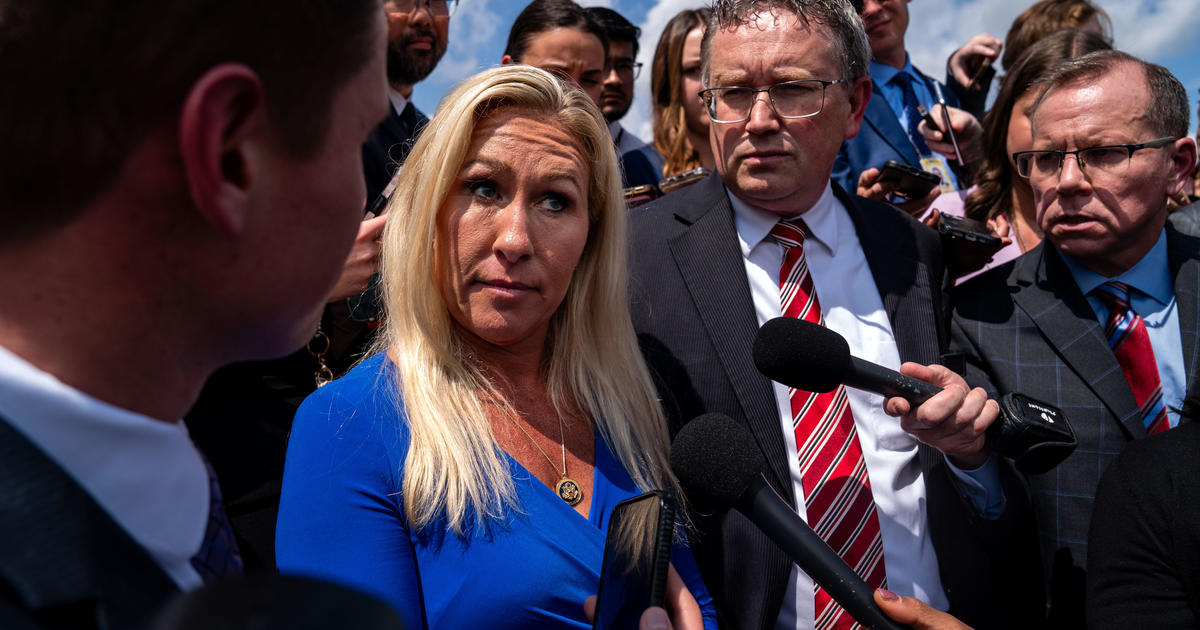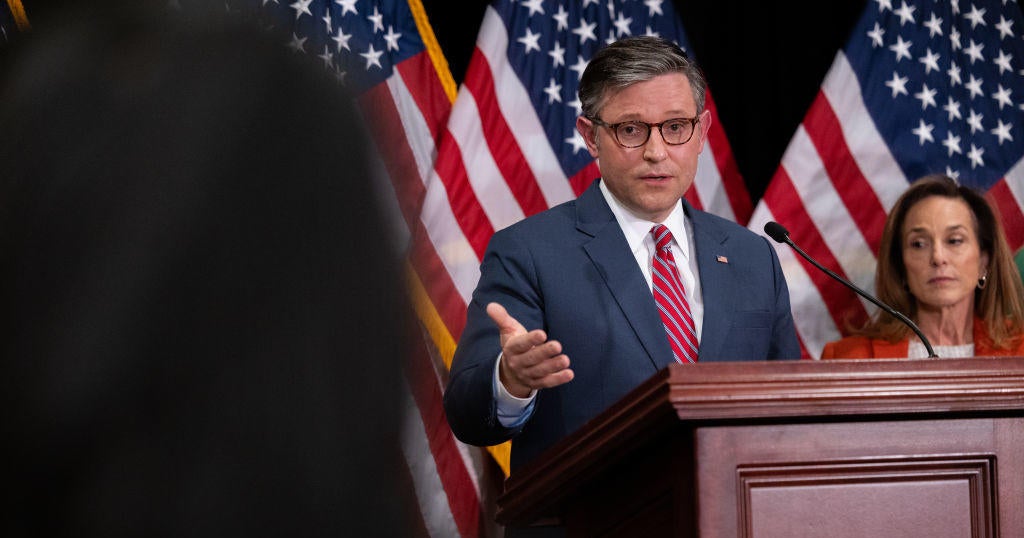CBS News
Marjorie Taylor Greene backs away from imminent threat to oust House Speaker Mike Johnson

Washington — Rep. Marjorie Taylor Greene appeared to retreat from her threat to imminently trigger a vote to remove Speaker Mike Johnson as House leader after lengthy meetings with him this week.
“Right now the ball is in Mike Johnson’s court,” Greene said Tuesday. She added that the timeframe for following through on her promise to force a vote is “up to Mike Johnson and it can’t drag out.”
She said Johnson was not given a “specific timeline, but it’s pretty short.”
Greene met Monday and Tuesday with Johnson as the Georgia Republican weighed the exact timing of forcing a vote to remove him from leadership. Greene said last Wednesday she would start the clock on a vote to overthrow Johnson, a Louisiana Republican, this week after dangling the threat since March.
Kent Nishimura / Getty Images
But she emerged from the meetings to offer few details about her plans to force a vote, signaling that tensions could be cooling — at least until he makes another misstep in the eyes of the far-right.
Greene demanded that Johnson promise no more aid for Ukraine, no bill be brought to the floor unless the majority of Republicans support it, stripping funding for Justice Department investigations into former President Donald Trump and automatic spending cuts if the 12 appropriations bills are not passed individually.
“I have high expectations and they have to be met in full,” Greene said in an interview with former Trump adviser Steve Bannon on his “War Room” podcast before Tuesday’s meeting. “There is no middle ground, there is no compromise.”
Johnson, a Louisiana Republican, said Tuesday the initial conversation was “productive” and “it was not a negotiation.” He also described the second meeting as “productive” and said he was “optimistic” about finding a resolution on the suggestions. They did not have more meetings scheduled, he said.
“I take Marjorie’s ideas and Thomas’ and everybody else’s equally and we assess them on their own value, and where we can make improvements and changes and all of that, we do. That’s what this is. There’s nothing more than that going on,” he said Tuesday morning.
Rep. Thomas Massie, a Kentucky Republican, joined both meetings. He and GOP Rep. Paul Gosar of Arizona are the only two Republicans who have publicly backed Greene’s effort at this point.
Johnson has repeatedly noted that he’s leading a divided majority with a one-vote margin. Special elections in May and June to fill the seats of Republicans who retired in recent months are expected to help give more cushion to the GOP majority.
If Greene does eventually trigger a vote, Johnson is expected to survive the attempt to strip him of the gavel thanks to Democratic support that puts him in a stronger position despite the GOP’s razor-thin margin of control. Democrats said they would thwart the effort to remove him after he defied conservative members of his party to support more aid to Ukraine.
Democrats offering to help a GOP leader keep his power demonstrates how far conservatives’ unwillingness to compromise has pushed the House toward this unique moment. But Democrats say the move is more about beating back the far right than saving Johnson.
“Our view would traditionally be, ‘Let the other side work its own mess out,'” House Minority Leader Hakeem Jeffries, a New York Democrat, recently told “60 Minutes.” “But when that mess starts to impact the ability to do the job on behalf of the American people, then the responsible thing at that moment might be for us to make clear that we will not allow the extremists to throw the Congress and the country into chaos.”
Johnson said Tuesday he expects to remain in power next year.
“I intend to lead this conference in the future,” he said at his weekly news conference. “I expect I’ll be doing that in the future. I’m glad to have the support of President Trump.”
Nikole Killion and Jaala Brown contributed reporting.
CBS News
Photographing the rooms of kids killed in school shootings

An unmade bed
A library book 12 years overdue
The next day’s outfit
Notes to her future self

Click on the door to enter
CBS News
How do you make a portrait of a child who isn’t there? Photographer Lou Bopp found a way, but it wasn’t easy.

In early 2018, I was deplaning after an 18-hour flight when Steve Hartman called. He had an idea: to photograph the still-intact bedrooms of kids who had been killed in school shootings.
It’s a headful. And six years later, I still don’t have an “elevator pitch” for the project — but then, I don’t often talk about this project. It is by far the most difficult I have ever worked on.
When Steve, my friend of about 25 years, asked me if I would like to be involved, I said yes without hesitation — even though I didn’t think we would get any families to agree. There is no way that I would have said no to partnering with him on this.
Emotionally, I was not sure how I would get through it. Within a few months I was on my way to Parkland, Florida. Alone. I’m not sure that I realized that I would be on my own.
But here I was. An on-location commercial photographer who focuses on people and pets to create compelling, honest, textural and connective moments for large brands, per my LinkedIn professional profile, on a project where there is no one to take photos of — for the most brutal of reasons.
How do you make a portrait of a child who is not there?
In each of these children’s rooms — the most sacred of places for these families — there was the sense that the child had just been there, and was coming right back. It was as if they’d just left their room like that when they went to school in the morning and were returning in the afternoon.
I wanted to capture that essence.
Most kids’ bedrooms are their very own special places, and these were no different. I looked everywhere, without touching anything. I photographed inside trash cans, under beds, behind desks. Their personalities shone through in the smallest of details — hair ties on a doorknob, a toothpaste tube left uncapped, a ripped ticket for a school event — allowing me to uncover glimpses as to who they were.
But there was an emotional challenge in addition to that creative one. Over the course of more than six years, we visited with many families around the country. The parents I spoke with seemed grateful that I was there. But each time I received a call or text from Steve about a new family, my heart sank.
It meant another family had lost a child.
I find it unfathomable that children being killed at school is even an issue. It makes no sense. It’s impossible to process. The night prior to each one of the family visits, I didn’t sleep. And I knew I wouldn’t going into the project. It’s not a self-fulfilling prophecy. It is nerves. And empathy. And sorrow. And fear.
In my notes from early on in the project, back in 2018, writing in seat 6H on the flight back from Nairobi, I reflected on the emotional task ahead.
“This is going to be one of the most difficult things ever, emotionally, for me, and not just work related. As I read my research documents, I get visibly emotional,” I wrote, noting my gratitude that the dark cabin prevented the other passengers from seeing me.
The prospect brought my own fears to the fore, both for myself — “I can’t help thinking about Rose,” my daughter, “and what if. I’ve lost sleep over envisioning the what-ifs well before Parkland” — and about and for meeting the families in the project: “When I read about April & Phillip and Lori’s plight, I somehow, for some reason put myself in their emotional position even though that is impossible, I have no idea, it’s beyond comprehension, I do not know what they feel. I do not know what I am going to say to them, I’m scared beyond belief. And alone.”
But just days later, I was photographing the first assignment for the project: Alyssa Alhadeff’s room. She was just 14 years old when she walked out of that room to head to Marjory Stoneman Douglas High School. I was shaky meeting the family friend who greeted me at the house. Her daughter was Alyssa’s best friend, and a photo of the two girls was on the table.
According to my notes, “The room was a beautiful teenager’s messy room. My emotions were kept in check the way that they usually are; By hiding behind the camera. I removed my shoes before entering. My heart was pounding and it reverberated through my body and soul, I felt like I was in one of the most sacred and special places on Earth. I was so careful not to touch anything.”
I left feeling ready to explode in sadness and anger.
Later that day, I photographed Carmen Schentrup’s room. Her younger sister had survived the Parkland shooting, but 16-year-old Carmen was killed in her AP Psychology class. Meeting her parents, April and Phillip, was what I was most scared of.
“I feel so much pain and compassion for them and I don’t want to say the wrong thing, drop cliches etc.,” I wrote at the time. “I spoke to Steve for guidance. He said, just be you. That’s all I can do. Just be me. He was right, those three words helped carry me through this entire project. Just be me.”
April let me in, and I worked quickly, only meeting Phillip as I was leaving. “The conversation felt like we all three were just trying to hold it together. I cannot imagine what they are going through, my heart hurts for them. This was / is such a painful project, and reconciling it will be impossible.
“I think about how anything can happen at any time to any of us. Literally. You never know,” I wrote.
After only about 16 hours on the ground in Florida, I was done with the first portion. I felt the project was a must, but I also dreaded the next call from Steve about the next family. I didn’t know when that call would come — many years later, or the very next day, possibly never.
But last month, we — and the documentary crew that filmed us working — completed this project. While I haven’t seen it yet, I know Steve’s piece won’t be a typical Steve Hartman segment. How could it be? I know he struggled too, and we both have spent a lot of time processing this.
I remember one August evening, I was devastated as I left the home of one of the families. Within minutes, I passed an ice cream shop crowded with other families — seemingly carefree, full of joy and laughter. The juxtaposition, mere minutes apart, cracked my soul.
I hope some way, somehow, this project can facilitate change — the only possible positive outcome for this I could comprehend. After the news cycle ends, these families will still be living with an incomprehensible nightmare.
CBS News
Standing on the threshold of grief, documenting the bedrooms of kids killed in school shootings

I never wanted to be this kind of reporter, knocking on the door of someone who lost a child in a school shooting. And yet there I stood, knocking, nonetheless.
I found myself here, standing on the threshold of grief across the country, after years of pent-up frustration. By 2018, America’s school shooting epidemic had taken a toll on me. There were so many that the news coverage felt like a treadmill. It seemed to me the country had grown numb and lost its empathy for the victims and the families. I wanted to do something.
For help, I reached out to Lou Bopp, one of the best still photographers in the country. But he said he had never faced a challenge quite like this: “to take a portrait of a person who’s not there.”
On March 27, 2023, Chad and Jada Scruggs lost their daughter, Hallie, in the Covenant School shooting in Nashville. She was 9 years old, the youngest of four, and their only daughter.
Looking back at photos of Hallie, Chad recalled how she loved sports and had “more stitches than any of her brothers.”
“It was just a lot of fun having a daughter,” Jada said.
“We had a chance to have her for 9 and a half years, and that was far better than not having her at all,” Chad said.
But their goodbye isn’t quite complete. They’re still living with her bedroom.
Over the past six years, eight families from five school shootings invited us into these sacred spaces, allowing Americans to see what it’s like to live with an empty child’s bedroom.
We traveled to Uvalde, Texas, where a gunman killed 19 children and two teachers at Robb Elementary School, including 9-year-old Jackie Cazares.
Jackie’s parents Javier and Gloria say people are always telling them that they can’t imagine what they’re going through. But they say we need to imagine, and that’s why they invited us in.
“It just makes everything more real for the public, for the world,” Gloria said. “Her room completely just speaks of who she was.”
In Jackie’s room, we saw the chocolate she saved for a day that never came, evidence of the dream vacation she never got to take, and the pajamas she never wore again.
It struck us how many of the rooms remained virtually untouched, years after the shooting.
Frank and Nancy Blackwell lost their 14-year-old son Dominic in the Saugus High School tragedy near Los Angeles. That was 2019, but inside his room, it felt like it was yesterday.
“We just decided to keep everything as it was from when he last went to school that day,” Frank said. “He didn’t prepare his room to be photographed. He didn’t put away his stuffed animals because he was worried about who might see it. He woke up, he got dressed, and he left to go to school. And he thought he was coming back. And we all expected him to come back.”
So many rooms wait for a child that will never return.
Charlotte Bacon was murdered in Newtown, Connecticut, in 2012, six weeks after Halloween. Her room holds the last library book the 6-year-old checked out, now 12 years overdue.
Luke Hoyer, 15, was killed in Parkland, Florida, on Valentine’s Day in 2018. When we visited his home, his bed was just as he left it.
Alyssa Alhadeff, 14, was also killed in the Parkland shooting. The whirlwind that was her room had fallen still.
Carmen Schentrup was yet another Parkland victim. The watch she got for her 16th birthday still ticks, but the motivational sayings that filled her room resonate no more.
The decision to either keep a room as it was or pack it up and repurpose it tortures many parents.
Bryan and Cindy Muhlberger lost their 15-year-old daughter, Gracie, in the Saugus shooting. They told us they often talk about what to do with her room.
“Because when I do go in there, I feel her presence,” Cindy told us.
Bryan wondered, “And so when that time comes that the room is not there, does she go away?”
I didn’t realize what an albatross the rooms are for some families.
“I will just say I have a pretty confusing relationship with [Hallie’s] room now,” Chad said. It’s extremely painful, but there’s a lot of moments where you want to be sad — because the sadness is a part of connecting with her.”
Hallie’s room also brings them smiles, too, Chad and Jada told us as they showed us a kitty cat hoodie that Hallie wore all the time.
The rooms really are a rainbow of emotion, all at once tender as a lullaby and shocking as a crime scene. Clues gather dust, leading us past all the places these kids had been up until that very moment when everything stopped so suddenly that there wasn’t even time to close the lid on the toothpaste tube.
In the end, we took more than 10,000 photographs. These parents hope that at least one of these pictures will stick with you, that you will forever carry a piece of their pain and use that heartache to stem the tide of all these empty rooms.










